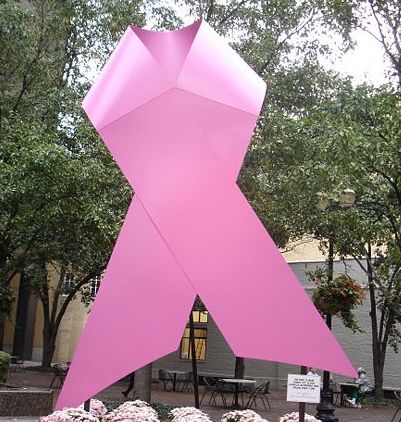breast cancer awareness and the problem with pinktober
October is breast cancer awareness month, which means that everything from street posts to hair products to storefront windows are decked in pink. Women and men don ‘save the tatas’ t-shirts and wristbands, all in the name of breast cancer awareness. We are aware of breast cancer as a disease but we are unaware of how detrimental it is to sexually objectify it, paint it pink, and market it in every way imaginable. This distracts from any meaningful progress in breast cancer research by depicting the disease in an unrealistic manner.
The persistent sexualisation of breasts in advertising is very much alive in breast cancer awareness ads. These ads feature beautiful women scantily clad in uber-feminine clothing (if they aren’t almost totally naked) and clutching their breasts in an almost erotic fashion. This example is almost banal in comparison to the ‘save second base’ apparel that is readily available to order online. Since society seems to think that women exist solely for men’s pleasure, their mortality is trivialised with regard to how sexually attractive they are to that group. Don’t worry about saving breasts for the sake of male pleasure, worry about saving human lives. According to a report issued by the Australian Institute of Health and Welfare, an estimated 3,040 women will lose their lives to breast cancer in 2015. No amount of Photoshop or pink can cover up that statistic.
Take, for example, the sexy breast cancer awareness Halloween costume. The company, Yandy, uses 10% of the proceeds from each of the costume’s furry leopard accessories to benefit breast cancer research and awareness. The giant pink ribbon that is featured in the product picture is not regulated by any agency, meaning that anyone can slap a pink ribbon onto their product and claim that its proceeds support breast cancer research. The truth is that most of us can’t tell how much of our money goes to supporting breast cancer programs.
The Susan G. Komen for the Cure Foundation is the creator of this worldwide pink ribbon trend. The foundation’s founder and CEO Nancy Brinker makes a whopping AUD$941,118 a year, while less than 20% of donations from pink ribbon promotions and sales go to breast cancer research. The foundation has also sued “competing” charities, using money donated from people who care about cancer prevention and hiring attorneys to sue other charities.
This leads us to consider the term “pinkwashing.” A “pinkwasher,” as defined by the Breast Cancer Action organisation, is a ‘company or organisation that claims to care about breast cancer by promoting a pink ribbon product, but at the same time produces, manufactures and/or sells products that are linked to the disease.’
The shady dealings of the Susan G. Komen Foundation characterise this definition to no fault. Recently, the foundation has partnered with leading global fracking corporation Baker Hughes in distributing drill bits “for the cure.” It is proven that 25% of chemicals used in fracking increase our risk of getting cancer. The irony does not end here. Ever walked down the wine aisle of a grocery store, only to find necks of wine bottles wrapped in pink ribbons? Drill for the cure. Drink for the cure. Perhaps we should consider donating directly to breast cancer programs and organisations to ensure that our money does not benefit such questionable marketing tactics.
The horrific part of all of this is that pinkwashing the disease makes people take it less seriously. Consumers feel that they’ve helped the cause without understanding their odds of getting the disease. Commercials circulate the same basic message of the importance of mammograms and checking for lumps. They leave out what men should do if they are diagnosed with breast cancer. Instead, they focus on the emotional appeals and stories that will convince consumers to buy a pink tape dispenser in the shape of a high-heeled shoe.
Breast cancer awareness cannot keep focusing on making an epidemic comfortable and cute. Women and men who are at risk for the disease do not change their health behaviours as a result of overtly sexual PSAs that are riddled with gender cues. Awareness always has its place when it comes to breast cancer, but the emphasis on the “breast” rather than the “cancer” is distasteful. We cannot mind-numbingly promote the pink ribbon cause without realising how damaging it is to advancing breast cancer research. With this attitude, maybe we can shift the focus to fact-based breast cancer awareness that moves beyond the month of October.


